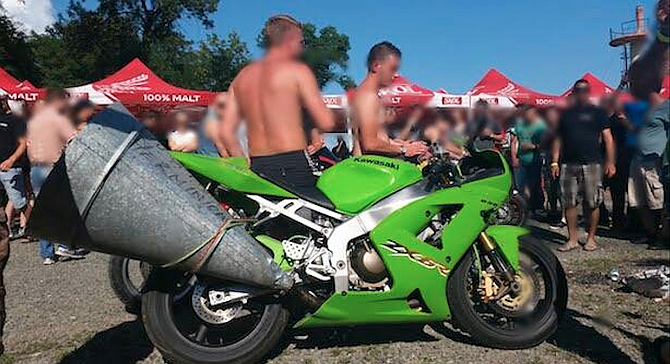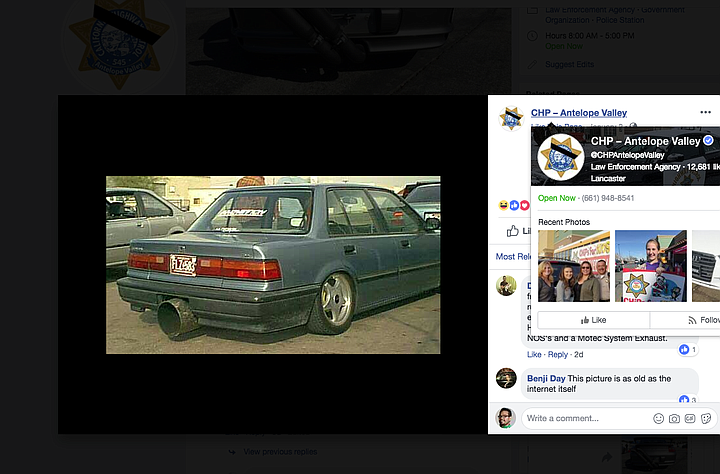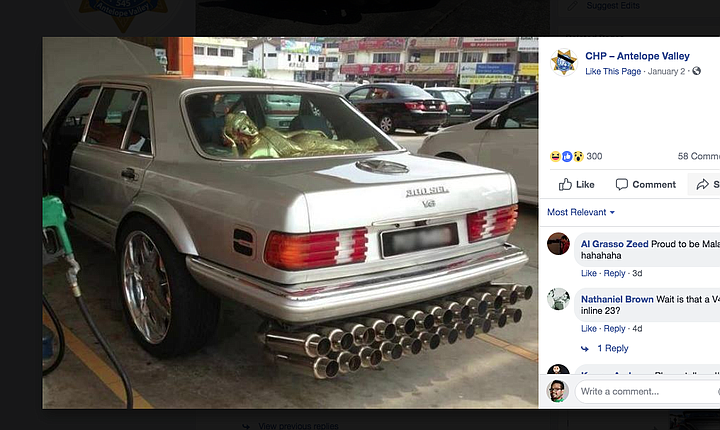 Facebook
Facebook
 X
X
 Instagram
Instagram
 TikTok
TikTok
 Youtube
Youtube

Some San Diegans are up in arms about the California exhaust ticketing bill that was signed into law by Jerry Brown in June. On January 1 the law went into effect.
“Does that mean I have to pay $1000 if I get pulled over for my exhaust system?” asked Jay, a Skyline resident and import-car racer.
“Now, I have to find a stock exhaust system and then reinstall it on my car, and that complete system with original pipes, mufflers and resonators is going to be hard to find.”

On January 8, I spoke to Officer Sanchez from the California Highway Patrol and asked about the alleged $1000 exhaust ticket that Jay and dozens of San Diegans spoke about online.
“All this law did was make a fine mandatory, as opposed to correctible,” Sanchez said. “So when these tickets were $1000 before, people weren’t paying because they were fixing their car [and] now they are saying: 'You got to fix your car and you have to pay a fine.' ”
Auto and motorcycle enthusiasts from San Diego County questioned the legal noise limits exuding from their exhaust systems; some posted questions, statements, memes and emojis (mostly middle fingers) — on Instagram, Reddit, and Facebook.
A few San Diegans saw and responded to a January 2 California Highway Patrol (Antelope Valley) Facebook post. The post contained photos of motorcycles and automobiles with extremely large and multiple muffler setups and captioned the post: “If you feel your vehicle is grossly negligent in this area, removing resonators, deleting mufflers, etc. You know who you are. Don’t waste your hard-earned money on this violation.” A few days later, the CHP post that had over 2800 shares, 2000 reactions (many which were angry and crying faces) and 2,300 comments was then deleted.

Tony from Jack’s Muffler in North Park says the Antelope Valley CHPs accusations were spot on. I spoke to Tony on January 9.
“Customers ask me to remove the mufflers and resonators,” he said, “and ask me to install a muffler delete or a straight pipe here and here,” he said.
He added that mufflers and resonators act as sound deadeners in the exhaust system – think of "yelling through a pillow."
“That’s a good thing,” Tony said. “I hate those loud motorcycles late at night and early in the morning.”
“Especially those Harleys,” said Jay, “and Hellcats (Dodge Challenger SRT) — they come out of the box with loud-ass exhausts.”
According to the AAA website: in California, “A noise limit of 92 decibels (dBA) applies to any motorcycle manufactured before 1970. A noise limit of 88 decibels applies to motorcycles manufactured after 1969 and before 1973; 86 decibels applies to motorcycles manufactured after 1972 and before 1975; 83 decibels applies to motorcycles manufactured after 1974 and before 1986; 80 decibels applies to motorcycles manufactured after 1985. Motorcycles registered in the state that are manufactured on or after 2013 or have an aftermarket exhaust system manufactured on or after 2013 must have the federal EPA noise emission label affixed to it in order to be operated, used, or parked in the state.”

According to the California vehicle code: “For the purposes of exhaust systems installed on motor vehicles with a manufacturer’s gross vehicle weight rating of less than 6,000 pounds, other than motorcycles, a sound level of 95 dbA or less, when tested in accordance with Society of Automotive Engineers Standard J1169 May 1998, complies with this section. Motor vehicle exhaust systems or parts thereof include, but are not limited to, non-original exhaust equipment.”
“So how are they going to measure the sound from our exhaust systems?” Jay wondered.
“There’s not an officer that carries a decibel monitor,” Sanchez said. “What officers in most cases do is they will articulate where they were [and] how far away they were. If I’m 50 feet away and my windows are closed and I can hear your vehicle; just based on those circumstances that’s probably going to be too loud. That’s how an officer would testify or [probably] why they cited that specific section.”
I told Jay about the decibel noise meters that can be downloaded onto our smartphones for free. “…. but see if the judge will buy that [decibel reading] when you fight your ticket,” he said. “How [explicative] loud is 95 [dBA], dude?”
According to the California Department of Transportation website, an activated food blender at about three feet emits about 95 dBA which is the noise limit for vehicles weighing less than 6000 lbs.; a diesel truck that’s 50 feet away driven at 50 mph emits about 80 dBA, which is the legal threshold for motorcycles manufactured after 1985.
“If you disagree with the officer and don’t believe you are in violation of the law,” Sanchez said, “that’s when you go to traffic court, and that’s where it should be argued.
“If an officer issues a citation, it doesn’t mean that that’s the fine you have to pay. If you go to court it’s up to a judge to make that determination on whether the fine should be imposed or not. Nothing is concrete.”
On January 10, Specialty Equipment Market Association posted information in regards to the exhaust bill which reads in part: “According to the Judicial Council of California’s Uniform Bail and Penalty Schedules for 2019, the suggested base fine/fee for a first conviction is $25 with a total fee of $193.
“Consumers in receipt of a ticket still have the option of seeking a certificate of compliance from the California Bureau of Automotive Repair demonstrating that their exhaust emits no more than 95 decibels."


Some San Diegans are up in arms about the California exhaust ticketing bill that was signed into law by Jerry Brown in June. On January 1 the law went into effect.
“Does that mean I have to pay $1000 if I get pulled over for my exhaust system?” asked Jay, a Skyline resident and import-car racer.
“Now, I have to find a stock exhaust system and then reinstall it on my car, and that complete system with original pipes, mufflers and resonators is going to be hard to find.”

On January 8, I spoke to Officer Sanchez from the California Highway Patrol and asked about the alleged $1000 exhaust ticket that Jay and dozens of San Diegans spoke about online.
“All this law did was make a fine mandatory, as opposed to correctible,” Sanchez said. “So when these tickets were $1000 before, people weren’t paying because they were fixing their car [and] now they are saying: 'You got to fix your car and you have to pay a fine.' ”
Auto and motorcycle enthusiasts from San Diego County questioned the legal noise limits exuding from their exhaust systems; some posted questions, statements, memes and emojis (mostly middle fingers) — on Instagram, Reddit, and Facebook.
A few San Diegans saw and responded to a January 2 California Highway Patrol (Antelope Valley) Facebook post. The post contained photos of motorcycles and automobiles with extremely large and multiple muffler setups and captioned the post: “If you feel your vehicle is grossly negligent in this area, removing resonators, deleting mufflers, etc. You know who you are. Don’t waste your hard-earned money on this violation.” A few days later, the CHP post that had over 2800 shares, 2000 reactions (many which were angry and crying faces) and 2,300 comments was then deleted.

Tony from Jack’s Muffler in North Park says the Antelope Valley CHPs accusations were spot on. I spoke to Tony on January 9.
“Customers ask me to remove the mufflers and resonators,” he said, “and ask me to install a muffler delete or a straight pipe here and here,” he said.
He added that mufflers and resonators act as sound deadeners in the exhaust system – think of "yelling through a pillow."
“That’s a good thing,” Tony said. “I hate those loud motorcycles late at night and early in the morning.”
“Especially those Harleys,” said Jay, “and Hellcats (Dodge Challenger SRT) — they come out of the box with loud-ass exhausts.”
According to the AAA website: in California, “A noise limit of 92 decibels (dBA) applies to any motorcycle manufactured before 1970. A noise limit of 88 decibels applies to motorcycles manufactured after 1969 and before 1973; 86 decibels applies to motorcycles manufactured after 1972 and before 1975; 83 decibels applies to motorcycles manufactured after 1974 and before 1986; 80 decibels applies to motorcycles manufactured after 1985. Motorcycles registered in the state that are manufactured on or after 2013 or have an aftermarket exhaust system manufactured on or after 2013 must have the federal EPA noise emission label affixed to it in order to be operated, used, or parked in the state.”

According to the California vehicle code: “For the purposes of exhaust systems installed on motor vehicles with a manufacturer’s gross vehicle weight rating of less than 6,000 pounds, other than motorcycles, a sound level of 95 dbA or less, when tested in accordance with Society of Automotive Engineers Standard J1169 May 1998, complies with this section. Motor vehicle exhaust systems or parts thereof include, but are not limited to, non-original exhaust equipment.”
“So how are they going to measure the sound from our exhaust systems?” Jay wondered.
“There’s not an officer that carries a decibel monitor,” Sanchez said. “What officers in most cases do is they will articulate where they were [and] how far away they were. If I’m 50 feet away and my windows are closed and I can hear your vehicle; just based on those circumstances that’s probably going to be too loud. That’s how an officer would testify or [probably] why they cited that specific section.”
I told Jay about the decibel noise meters that can be downloaded onto our smartphones for free. “…. but see if the judge will buy that [decibel reading] when you fight your ticket,” he said. “How [explicative] loud is 95 [dBA], dude?”
According to the California Department of Transportation website, an activated food blender at about three feet emits about 95 dBA which is the noise limit for vehicles weighing less than 6000 lbs.; a diesel truck that’s 50 feet away driven at 50 mph emits about 80 dBA, which is the legal threshold for motorcycles manufactured after 1985.
“If you disagree with the officer and don’t believe you are in violation of the law,” Sanchez said, “that’s when you go to traffic court, and that’s where it should be argued.
“If an officer issues a citation, it doesn’t mean that that’s the fine you have to pay. If you go to court it’s up to a judge to make that determination on whether the fine should be imposed or not. Nothing is concrete.”
On January 10, Specialty Equipment Market Association posted information in regards to the exhaust bill which reads in part: “According to the Judicial Council of California’s Uniform Bail and Penalty Schedules for 2019, the suggested base fine/fee for a first conviction is $25 with a total fee of $193.
“Consumers in receipt of a ticket still have the option of seeking a certificate of compliance from the California Bureau of Automotive Repair demonstrating that their exhaust emits no more than 95 decibels."
Comments